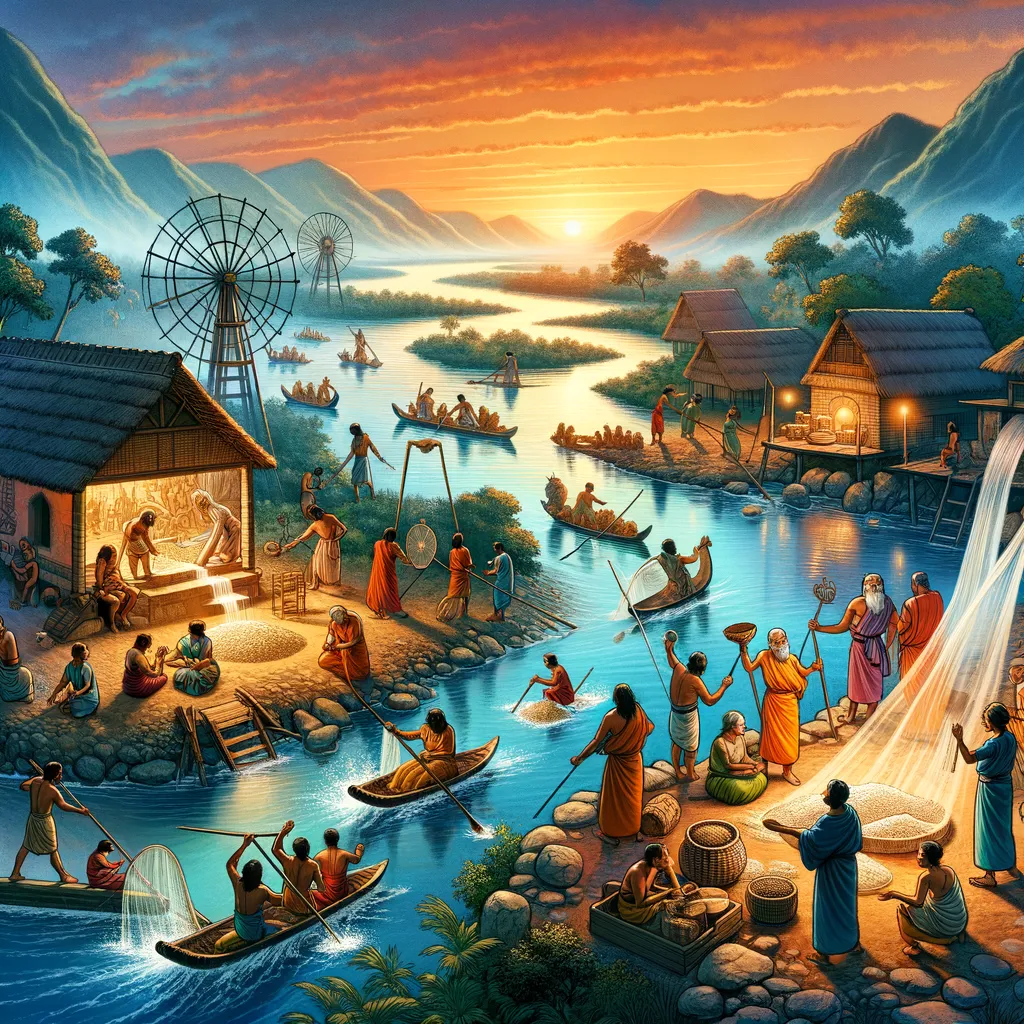Exploring the Ancient Lifelines: The Historical Uses of Rivers in Ancient Civilizations
Welcome to a journey back in time, where rivers were the cradles of civilization and the lifelines of ancient societies. From the lush banks of the Nile to the bustling waters of the Euphrates, rivers have played a crucial role in the development, sustenance, and expansion of ancient civilizations. This article will delve into the multifaceted roles rivers have played throughout history, serving as avenues for trade, agriculture, and cultural exchange. If you’re a parent seeking to educate your child on the importance of rivers in the ancient world, or simply a history enthusiast, join us on this fascinating exploration. And, remember to make your next outdoor adventure enriching by incorporating some history along the way. Check out Camping ideas and gear, or explore Outdoor Activities that can bring the whole family closer to nature and our ancestral roots.
The Cradle of Civilization
The term “Cradle of Civilization” is often attributed to regions along rivers such as the Nile, Tigris, Euphrates, and the Indus. These rivers provided fertile land for agriculture, which in turn sustained large populations and led to the development of complex societies. The consistent flow of these rivers allowed ancient farmers to develop irrigation systems, thus revolutionizing agriculture and enabling the growth of cities. For example, the Nile River’s flooding cycle was so predictable that the Egyptians were able to create a calendar system based on it, further highlighting the deep connection between rivers and the advancement of ancient civilizations.
Highways of Trade and Communication
Rivers in ancient times were the highways of the ancient world, facilitating trade and communication between distant regions. Goods such as grain, spices, precious metals, and textiles were transported along these waterways, connecting various civilizations and fostering economic and cultural exchanges. The Nile, for example, was Egypt’s main artery through which it interacted with the rest of Africa and the Mediterranean world. Similarly, the Mesopotamian civilizations (Sumerian, Assyrian, and Babylonian) owed much of their prosperity to the Tigris and Euphrates rivers, which enabled them to trade with neighboring regions and build powerful empires.
Source of Sustenance and Settlement
Rivers were not only vital for agriculture and trade but also served as the primary source of fresh water for drinking, bathing, and other daily activities. The establishment of settlements and eventually great cities often coincided with the proximity to rivers. This is evident in the positioning of cities such as Memphis and Thebes along the Nile, Babylon by the Euphrates, and Mohenjo-Daro by the Indus River. The strategic importance of these locations cannot be overstated, as they provided access to essential resources, enabled agricultural development, and protected the settlements from invasions.
Cultural and Religious Significance
Rivers also held profound cultural and religious significance for many ancient civilizations. They were seen as sacred entities and were often personified as gods or associated with religious myths and rituals. The Nile was worshiped as the giver of life in Egypt, while in Hinduism, the Ganges River is considered the most sacred and is believed to purify the souls of those who bathe in her waters. These beliefs underline the deep spiritual connection between rivers and the ancient peoples who lived by them, further emphasizing the river’s role in shaping not just the physical but also the metaphysical landscape of ancient civilizations.
In this guide, we’ve only just begun to unravel the rich tapestry of history surrounding the roles of rivers in ancient civilizations. As we continue, we will explore more in-depth stories of how these mighty waterways shaped the course of human history, paved the way for technological advancements, and left a lasting legacy on our social, economic, and spiritual lives. Stay tuned as we dive deeper into the currents of the past, uncovering more about these fascinating waterways that were so crucial to the development of the ancient world.

Unveiling the Past: Riveting Insights into the Historical Use of Rivers in Ancient Civilizations
Join us on an enthralling voyage through time, discovering how rivers were not just water bodies but the very heartbeat of ancient civilizations. Whether you are a parent eager to impart the wisdom of ancient practices derived from rivers to your children, or a history aficionado keen on exploring the profound impact of rivers on the ancients, this guide is your treasure trove of knowledge. Rivers, with their ceaseless flow, nourished lands, fostered trade, and cradled the earliest civilizations. They were the silent witnesses to human evolution, from agriculture to the zenith of cultural and technological advancements. Dive into our comprehensive guide and, for those adventurous families, don’t forget to check out Camping for gear and ideas on how to blend your next outdoor adventure with a touch of history. Also, explore Outdoor Activities to connect with nature and trace the steps of our ancestors.
Essentials for Parents: Preparing for a Journey through the Historical Uses of Rivers
1. The Agricultural Revolution Sparked by Rivers
Understanding the transformative role rivers played in agriculture is crucial. Ancient civilizations near the Nile, Tigris-Euphrates, and Indus rivers thrived on farming practices that were revolutionary at their time. The predictable flooding of the Nile and the intricate irrigation systems developed by Mesopotamians around the Tigris and Euphrates rivers underline how ancient societies adapted to their environments, leveraging river resources for agriculture. These narratives can inspire children to appreciate modern farming practices and the importance of water management.
2. Trade and Commerce: The Economic Arteries
Rivers were the economic lifelines, connecting different civilizations through trade. Goods, cultures, and ideas flowed along these natural highways. The Nile served as a conduit for interactions between Egypt, Africa, and the Mediterranean, while the Mesopotamian civilizations thrived by trading along the Tigris and Euphrates. When discussing this with children, highlight how rivers enabled not just the exchange of commodities but also facilitated cultural exchanges, laying the groundwork for the interconnected world we live in today.
3. Settlements and Early Metropolises
The proximity to rivers was pivotal in the establishment of settlements and the eventual rise of cities. Discussing the strategic placement of cities like Memphis, Thebes, Babylon, and Mohenjo-Daro near rivers can highlight the importance of water in urban planning and development. It also serves as an excellent opportunity to discuss how geography influences civilization development and the strategic considerations in ancient times which can be contrasted with modern-day city planning.
4. Spiritual and Cultural Significance
Rivers were revered as sacred in many ancient cultures, embodying religious and cultural sentiments. For instance, the Nile’s significance in Egyptian culture as the giver of life and the Ganges in Hinduism as a purifier of souls offer rich narratives about how ancient peoples intertwined spirituality with natural elements. Sharing these stories with children can foster a deep appreciation for the cultural diversities and the role of nature in spiritual practices around the world.
5. Technological Innovations Stemming from River Cultures
Lastly, exploring the technological advancements spurred by the needs and challenges of ancient river civilizations can be incredibly inspiring. From the development of the shaduf in Egypt, an early irrigation tool, to the creation of water mills for grinding grain, rivers were at the heart of many technological innovations. Such discussions can stimulate curiosity about science, engineering, and technology among children, showcasing how environmental challenges can lead to significant human ingenuity.
Embarking on a journey through the historical uses of rivers in ancient civilizations not only enriches our understanding of human history but also connects us with the perpetual influence of nature on human development. This exploration offers invaluable lessons on sustainability, cultural respect, technological innovation, and the importance of preserving our natural resources for future generations.
In drawing from the past, we find timeless wisdom and insights that are profoundly relevant in today’s world. As we navigate through the stories of ancient rivers, we glean lessons that can guide us in addressing contemporary challenges, enriching our lives, and inspiring a profound respect for the natural world that sustained our ancestors. So, let’s continue to dive deeper into the currents of the past, uncovering more captivating stories about these incredible waterways that shaped the course of human civilization.
Disclaimer
The articles available via our website provide general information only and we strongly urge readers to exercise caution and conduct their own thorough research and fact-checking. The information presented should not be taken as absolute truth, and, to the maximum extent permitted by law, we will not be held liable for any inaccuracies or errors in the content. It is essential for individuals to independently verify and validate the information before making any decisions or taking any actions based on the articles.



